All about the field bindweed
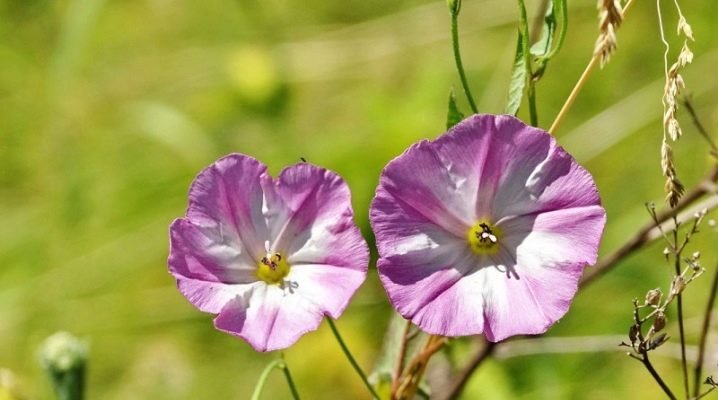
Field bindweed in a garden plot can manifest itself both as a malicious weed and as an elegant ornamental plant. In any case, it is useful for every gardener to know how to grow a given crop and how to destroy it.
Description
Field bindweed, whose scientific name in Latin sounds like convolvulus arvensis, belongs to the bindweed family. A botanical description of a crop, often referred to as a birch, indicates that the plant is a malign perennial weed. The length of the shoots reaches a maximum of 2 meters, although the average is from 30 to 150 centimeters. With the help of these thin, intertwining stems, the bindweed envelops its neighbors and bends them to the ground. The birch tree has oblong green leaf blades, and in the second year of life, white or pink flowers appear with a diameter of up to 2 centimeters. Most often they grow one by one, but sometimes they gather in inflorescences of 3-5 pieces.
Having studied the formula of a flower, we can conclude that it has several planes of symmetry, 5 cups, 5 corollas, 5 stamens and 2 pistils.
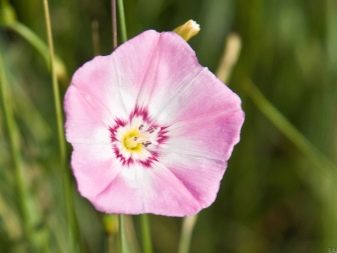
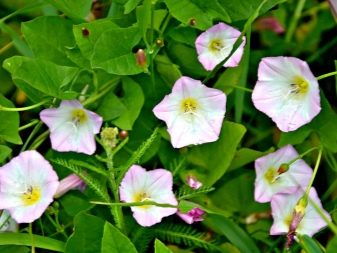
The culture has a very powerful root system. The main root sinks into the soil up to almost 6 meters and extracts moisture from levels where many plants simply do not get. The lateral roots live in the surface 30 centimeters of the soil and move 4 meters in different directions during the season. On these branches, buds are actively formed, from which, in turn, shoots hatch - up to 200 copies on each bush. It is interesting that if a two-centimeter piece of root is placed in a moist soil, and at least one bud is found on it, then soon a completely viable bindweed will appear on the surface. The characteristics of the culture indicate that it is propagated by seeds. Their germination occurs even at a temperature of + 4 ... 6 degrees at a depth of 10 to 15 centimeters. In the ground, their germination persists for 3 years, and in storage facilities this period reaches 50 years. Sowing material ripens from August to September. The picky bindweed is able to develop on any soil, although it still loves loose, nutritious and not waterlogged soil.
It should be mentioned that bindweed, although it looks beautiful, is capable of harming neighboring crops. In addition to the fact that the long stem bends other plants to the soil, the roots of the birch emit toxic substances. The presence of toxins in the soil leads to the fact that seeds germinate worse, seedlings experience developmental problems, and the amount of harvest is reduced. In addition, the crop rapidly "empties" the soil from moisture and nutrients, as a result of which the plants growing nearby suffer from drought and "hunger". The seeds of the bindweed, which ripen in fruits such as a four-leafed capsule, are also poisonous. Nevertheless extracts from the plant are used to treat a fairly wide group of diseases, and dry grass is used as winter feed for livestock.


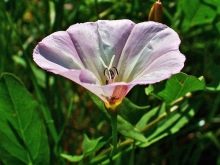
Spreading
The habitat of the bindweed in Russia is considered almost ubiquitous: the weed can be found in the Caucasus and Siberia, the Far East and Central Asia, as well as throughout the European part of the country. The culture grows on almost any, even the poorest soil: in meadows and glades, on wastelands and on roadsides, in well-tended gardens and on uncultivated areas.
Growing and decorative use
The field bindweed, grown for decorative purposes, propagates with the help of seeds. Sowing material in open ground is carried out not earlier than April 15, and even better in May. As soon as the first shoots appear on the surface, they are necessarily thinned out so that 15-20 centimeters of free space remain between individual specimens. There is also an option with preliminary preparation of seedlings: in March, the seeds are distributed in pots, and there are several grains for each container.

The temperature in the place where the containers are located is maintained at +20 degrees. Seedlings are transferred to open ground in May. The beginning of budding should be accompanied by the introduction of complex mineral fertilizers in liquid form. Water the crop regularly, but not excessively, so that moisture does not accumulate at the roots.
Irrigation usually starts in late spring and lasts until September. The culture often suffers from aphid and spider mite attacks. Folk remedies help fight pests. For example, bindweed is processed with dandelion infusion. The product is prepared from 0.5 kilograms of freshly crushed leaves and 8-10 liters of warm water, after which it is infused for 3 hours. In landscape design, bindweed can be used to organize vertical flower beds. The plant "starts up" on a fence or a wall instead of ivy or clematis, and is also selected for quick ennobling of any cluttered area. To make the thickets look neat, you will have to periodically monitor so that the antennae look in the required direction.
Field bindweed is suitable for creating compositions on flat lawns, as well as decorating flower beds and rocky gardens.

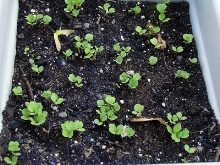

How to get rid of weeds in the garden?
For most gardeners, bindweed, however, is an annoying weed, which takes a lot of time to remove.
Mechanical methods of struggle
One of the most effective ways to get rid of bindweed is considered exhaustion. The essence of the procedure is that young shoots are removed at an early stage, that is, until they turn green and open the first leaves. You have to act in a limited time period - 2-3 days after the appearance of the plant on the surface, but this allows you to get rid of the problem for a long time. However, you will have to repeat the procedure several times - approximately 3-5 times per season. The effectiveness of depletion is explained by the specifics of the development of the bindweed.
A similar mechanical method of killing grass requires less effort and is not very time-consuming. In this case, first, the earth is loosened to a depth of 7 to 10 centimeters, and in parallel, the rhizomes are crushed into small pieces. After about a week, many new shoots should appear. They have to be cut or mowed before the bindweed reaches a height of 10-15 centimeters. Usually this procedure is carried out after a week and a half. Then the operation is repeated. It is important not to allow the overgrowth of shoots, otherwise the culture will acquire lateral roots with new buds, and it will be impossible to stop it.
Another way to eliminate weeds is suffocation... At first, the earth is loosened to a depth of up to 10 centimeters, as a result of which rhizomes are cut into tiny fragments. As soon as abundant shoots appear on the surface, the site is dug up again, but with the burial of the shovel already 25 centimeters.
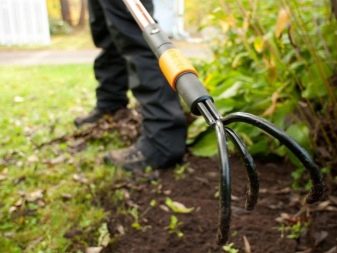
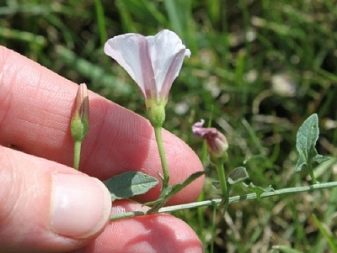
Movements should be made in such a way so that the top layer of soil is at the bottom. As a result, the seedlings will be so deep that they can no longer find themselves on the surface: the distance will play a role, and the fact that the pieces of rhizomes will not be enough for nutrition.
The essence of multiple deep loosening is that 3-4 times per season, the root shoots of the culture are cut to a depth of 10-14 centimeters. The result is that young plants appear in smaller numbers, and, in general, much slower. However, the effectiveness of this method leaves much to be desired: to completely eliminate the weed, several dozen treatments have to be carried out, spending a total of 2 years. If you have to save a small bed that is not too overgrown with bindweed, then you can simply pull out the grass by hand, and be sure to remove the rhizomes. Weeding in this case will be required every 3 weeks so that the weed does not have the opportunity to grow.
An effective remedy against weeds is three-stage peeling... The first stage is accompanied by deepening the instruments by 10-12 centimeters, and the second - by 15-20 centimeters. In the third stage, flat cutters or cultivators have to be immersed 25-30 centimeters into the soil.
I must say that mulching against bindweed does not particularly help. A tenacious weed is able to develop under any covering material and break through gravel.


Biological methods
The biological methods of combating bindweed include dense sowing of green manure: alfalfa, mustard, phacelia, rye or even sunflower. Since weeds prefer good lighting, close proximity, accompanied by the appearance of shade, will negatively affect its condition. It will not be possible to completely get rid of the weed in this way, but in a couple of years it will be possible to significantly reduce its number. It should be mentioned that the crops planted on the plots can attract rodents, and therefore, before wintering, such plants are recommended to be mowed and removed to another place.
Use of chemicals
Despite the fact that bindweed is resistant to most herbicides, some products still cope with the elimination of the problem. So, good reviews are received by "Napalm", "Glibest", "Fighter", "Sprut Extra" - that is, those preparations that contain glyphosate. However, one has to keep in mind that there are no products that are harmful only to weeds and safe for cultivated plants, and therefore treatment with herbicides is carried out either before sowing the main inhabitants of the beds, or after harvesting.
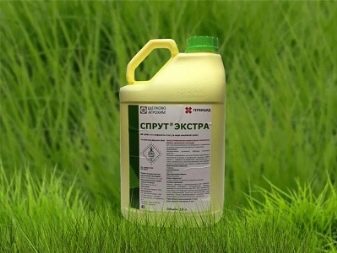

Experts do not recommend poisoning the bindweed until it reaches 20 centimeters in length. This is explained by the fact that until this stage there is a small number of leaves on the plant, which means that it will not be able to absorb the required amount of poison, and the procedure will be ineffective.
Nevertheless, you should not delay using herbicides either: it is best to carry out the treatment during the flowering of bindweed. Some gardeners, after harvesting, even first dig, getting rid of old weeds, and then, waiting for new ones to appear, they are already poisoning them with herbicides. Treatment with chemicals should be carried out in such a manner that at least another month remains before the autumn frosts. Four weeks will be enough for the toxins to reach the most distant branches of the root system and destroy them. Another important rule is use chemicals on a dry day, otherwise the raindrops will simply wash off the poison from the leaves into the soil.
Finally, treated bindweed, in general, cannot be cut off for about 2-4 weeks: if you mow the aerial part, then the toxin will stop getting to the rhizome, and the weed will survive.








































































































The comment was sent successfully.